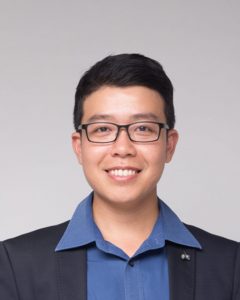September 1, 2023
By Huy Tran, MD, PhD & Xuan Nguyen, MD, MSc
 Although the underlying mechanism for myopia progression is uncertain, evidence supports the hypothesis that a lag of accommodation during near work can induce hyperopic defocus, which in turn triggers axial elongation.1,2 Indeed, children and young adults with myopia have been found to have a higher level of accommodative lag for the same stimulus distance than emmetropes.3 However, the relationship between accommodative lag and myopia progression is still controversial. While a study on about 600 myopic children found no association between accommodative lag and myopia progression reference,4 another study did show a link.5
Although the underlying mechanism for myopia progression is uncertain, evidence supports the hypothesis that a lag of accommodation during near work can induce hyperopic defocus, which in turn triggers axial elongation.1,2 Indeed, children and young adults with myopia have been found to have a higher level of accommodative lag for the same stimulus distance than emmetropes.3 However, the relationship between accommodative lag and myopia progression is still controversial. While a study on about 600 myopic children found no association between accommodative lag and myopia progression reference,4 another study did show a link.5
With that respect, the authors of this paper aimed to investigate this relationship with: (i) the amount of accommodative lag covering a range of stimuli from 0.00D to 6.00D and (ii) other accommodative parameters such as distance accommodative facility and slope of the accommodative stimulus-response curve (ASRC).
This longitudinal study analyzed the retrospective and prospective data from 113 Chinese children aged between 8 and 15 years, having spherical equivalent of -0.75D or worse and astigmatism less than -2.00D. Additionally, the Gompertz function was used to determine the rate of myopia progression at enrollment, and the accommodative stimulus-response curve was plotted to determine the accommodative lag area.
In summary, the study found that a younger onset of myopia and a faster rate of progression may result in high levels of myopia in later years. On the other hand, accommodative lag was suggested to have no influence on the myopia progression rate in the observed Chinese population.
Abstract
Accommodation is Unrelated to Myopia Progression in Chinese Myopic Children
Yunyun Chen, Björn Drobe, Chuanchuan Zhang, Nisha Singh, Daniel P. Siegel, Hao Chen, Jinhua Bao & Fan Lu.
This study shows accommodative accuracy and distance accommodation facility in myopic children do not play a role in myopia progression. In 144 subjects, the monocular distance accommodative facility (DAF) and continuous accommodative stimulus–response curves (ASRCs) were measured at the enrolment. Retrospective and prospective refraction with regard to the enrolment visit were obtained from the outpatient database system based on non cycloplegic subjective spherical equivalent refraction (SER). The rate of myopic progression at enrolment was the first derivative of the Gompertz function, which was fitted with each subject’s longitudinal refractive error data, including at least four records of SER with an interval of more than 6 months between each visit. A mixed linear model for multilevel repeated-measures data was used to explore the associations between the rate of myopia progression and accommodative parameters. The mean rate of myopia progression at enrolment was -0.61 ± 0.31 D/y with a mean age of 12.27 ± 1.61 years. By adjusting for age and SER, it was shown that the myopic progression rate was not associated with the accommodative lag (F = 0.269, P = 0.604), accommodative lag area (F = 0.086, P = 0.354), slope of ASRC (F = 0.711, P = 0.399), and DAF (F = 0.619, P = 0.432).
Chen, Y., Drobe, B., Zhang, C., Singh, N., Spiegel, D. P., Chen, H., … & Lu, F. (2020). Accommodation is unrelated to myopia progression in Chinese myopic children. Scientific Reports, 10(1), 12056.
DOI: https://doi.org/10.1038/s41598-020-68859-6
 |
Huy Tran, MD, PhD, is the Head of Myopia Control Clinic, Hai Yen Eye Care and a lecturer of the University of Medicine and Pharmacy at Ho Chi Minh City, Vietnam, and collaborates with BHVI on myopia-related projects. |
 |
Xuan Nguyen, MD, MSc, is a consultant ophthalmologist at Hai Yen Eye Care, Ho Chi Minh City, Vietnam, working on myopia-related projects in Vietnam. |
References
- Norton, T.T., et al. Effectiveness of hyperopic defocus, minimal defocus, or myopic defocus in competition with a myopiagenic stimulus in tree shrew eyes. 2006. 47(11): p. 4687-4699.
- Schaeffel, F., A. Glasser, and H.C.J.V.r. Howland. Accommodation, refractive error and eye growth in chickens. 1988. 28(5): p. 639-657.
- Gwiazda, J., et al. Accommodation, accommodative convergence, and response AC/A ratios before and at the onset of myopia in children. 2005. 82(4): p. 273-278.
- Berntsen, D.A., et al. Accommodative lag and juvenile-onset myopia progression in children wearing refractive correction. 2011. 51(9): p. 1039-1046.
- Gwiazda, J.E., et al. Accommodation and related risk factors associated with myopia progression and their interaction with treatment in COMET children. Investigative Ophthalmology & Visual Science, 2004. 45(7): p. 2143-2151.













